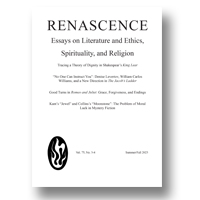|
2.
|
Renascence:
Volume >
68 >
Issue: 2
Norm Klassen
Mary’s Swollen Womb:
What It Looks Like to Overcome Tyranny in The Second Nun’s Prologue and Tale
abstract |
view |
rights & permissions
| cited by
Through the juxtaposition of an image (in the prologue) of Christ in Mary’s womb with that (in the tale) of Almachius as a bladder full of hot air, The Second Nun’s Prologue and Tale contributes to the theme in The Canterbury Tales of overcoming tyranny. While the nun’s tale alone presents an overly forceful apologetic, the image that Chaucer includes in her prologue subtly reminds audiences of a more paradoxical relationship between creator and creatures than that of either tyrant-and-subjects or tale-teller-and-audience-to-be-indoctrinated. Chaucer, if not so much the well-meaning nun, emulates the creator of freedom. So too does the tale-telling fellowship, which reveals Christ in its enduring togetherness, despite the attempts of individual tellers to have the last word.
|
|
|
4.
|
Renascence:
Volume >
68 >
Issue: 2
Laura Alexander
The Forbidden Space in Mary, Lady Chudleigh’s “Song: To Lerinda” (1703)
abstract |
view |
rights & permissions
| cited by
The Restoration poet Mary, Lady Chudleigh (1656-1710) includes in her Poems on Several Occasions (1703) a short but important work, "Song: To Lerinda," that blends sacred and sexual love between two women. Better known to readers for her proto-feminist perspective in The Ladies Defense (1701), Chudleigh expresses outrage about the poor treatment of wives, though in this work she does not go so far as to suggest a same-sex union as an alternative to traditional marriage for women. Several shorter works in the Poems allude to unorthodox forms of spiritual or erotic experience for women, including "Song: To Lerinda," which, like the majority of her writing, demonstrates Chudleigh’s intellectual range and deep reading of classical philosophy. Willing to take risks in her poetry, Chudleigh re-imagines the Platonic homoerotic love ideal, which she revises to include women’s same-sex desire in the "Song." The imagined experience between the two women in the poem communicates an erotic and philosophical ideal of communal love that embraces rather than rejects physical pleasure as a means of accessing a higher spiritual realm. The love relationship between the women challenges hetero-normative social patterns, and the speaker suggests that same-sex desire is spiritually and sexually preferable for them.
|
|
|
5.
|
Renascence:
Volume >
68 >
Issue: 2
Margarita E. Sánchez Cuervo
The Appeal to Audience Through Figures of Thought in Virginia Woolf’s Feminist Essays
abstract |
view |
rights & permissions
| cited by
This article discusses the presence of figures of thought in some well-known feminist essays by Virginia Woolf. The novelist and essayist was especially sensitive to the challenging situation of women throughout history as far as their personal and professional desire for equality in a male-centered society was concerned. Woolf tries to make readers aware of her feminist views by using expressive resources like figures of speech or schemes, tropes and figures of thought in her writing. Figures of thought can be defined as those specific gestures which are designed to interact with the audience. Their use is connected with the functional use of language in the sense that they may draw readers’ attention away from the textual content and toward the context. Since the essays chosen for this study were first read aloud or were written in the form of letters before being published, the appeal to audience may be more deliberate and thus effective. The figures analyzed are enallage of person, erotema, ecphonesis, prosopopeia, aposiopesis and prolepsis.
|
|





